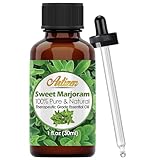Table of Contents
Marjoram does not grow wild in Europe. According to some researchers, the Crusaders knew of its many benefits and spread it during the Middle Ages. Due to its similarity with wild marjoram, a plant that, as its name says, grows wild in Europe, it was called native marjoram. Ancient Egyptians used marjoram as a seasoning plant and as a remedy. At present, it is a highly appreciated plant in phytotherapy.
- High Quality Marjoram Leaves-Heat Sealed for Freshness
- Guaranteed Fresh and High Quanlity
- 1 Pounds Bulk Bag, Enough to last for a while
- Originally Kosher then Repackaged in a non-Kosher Certified Facility-Similar to Basil and Oregano, great for chicken, stuffing, soups, sauces, salad and veggies

Scientific Facts
- Scientific Name: Origanum majorana L.
- Scientific Synonyms: Majorana hortensis Moench.
- Other Names: Sweet marjoram, knotted marjoram.
- French: Marjolaine.
- Spanish: Mejorana.
- Environment: Native to the Middle East, its cultivation soon spread to all Mediterranean countries of Europe and Africa. It is also cultivated in some American countries.
- Description: This vigorous plant of the Labiatae family grows from 15 to 40 cm high. Its white or pink flowers grow in clusters on the tip of the stems. Its aroma is between peppermint and thyme.
- Parts of the plant used medicinally: The flower clusters.
Marjoram Benefits

The active principles of marjoram are concentrated in essence and rich in terpenic substances such as terpineol. This essence has the following properties.

- Antispasmodic and digestive – The plant is beneficial for flatulence (carminative properties), nervous spasms of the stomach, and bloated stomach.
- Sedative – It is recommended to combat psychological excitation, nervousness, and insomnia. It is a good remedy against anxiety.
- Hypotensive – Marjoram decreases the tone of the sympathetic nervous system, which is responsible for arterial contraction. Moreover, the plant has diuretic properties.
- Expectorant and pectoral.
- Antirheumatic—When externally applied, the essence eases rheumatic aches and muscle contractions. It also has refreshing properties in lotions or when added to bath water.
How to use Marjoram
- Infusion with 40 to 50 grams of flower clusters per liter of water. Drink up to three cups daily.
- Essence – The recommended dose varies from four to six drops three times a day.
- Lotions with the essence dissolved in alcohol (10 to 20 drops in 100 cc. of alcohol).
- Baths – add some drops of essence to the bath water to achieve a notable antirheumatic effect.
Frequently Asked Question
I’ve heard marjoram has antioxidant properties. What types of antioxidants does it contain, and how significant are they?
The plant contains several potent antioxidants, including carvacrol, rosmarinic acid, and terpinene. These antioxidants help safeguard your cells from damage by free radicals, which can impact chronic diseases.
Does this plant have specific benefits for heart health?
Yes! It may act as a vasodilator, helping relax blood vessels and improve blood flow. This can help reduce blood pressure, a significant risk factor for heart disease. The plant’s antioxidant and anti-inflammatory properties may also offer protection against heart-related issues.
Can it help with menstrual irregularities and hormonal issues?
There’s some evidence that it may help regulate menstrual cycles and ease symptoms of menopause. It’s also been studied about polycystic ovarian syndrome (PCOS), with promising results for improving insulin sensitivity and hormone balance.
I struggle with anxiety. Could the plant have a calming effect?
The plant’s essential oil is often used in aromatherapy for its stress-reducing and soothing properties. Research suggests it may also reduce anxiety and promote relaxation.
Are there specific digestive conditions marjoram can help with?
Traditionally, it has been used to alleviate digestive complaints like flatulence, stomach cramps, and poor appetite. Some evidence suggests it may also help protect against stomach ulcers.
Can the plant be used topically for wound healing or skin conditions?
The plant has demonstrated antimicrobial and anti-inflammatory properties. This suggests potential benefits for topical use in wound healing and specific skin issues. However, more focused research is needed in this area.
Are there significant nutrient levels found in marjoram?
The plant is an excellent source of Vitamin K (necessary for blood clotting), Vitamin A (eye health), magnesium, and potassium.
Does the way marjoram is consumed matter (fresh, dried, essential oil, etc.)?
Yes! Different forms may offer varying degrees of health benefits. Fresh or dried forms can be used in cooking, teas, or tinctures. The essential oil is highly concentrated, used for aromatherapy, or diluted for topical application.
Are there interactions I should be aware of if I’m taking medications?
The plant might slow blood clotting, increasing the risk of bruising and bleeding in people taking blood thinners. It’s best to consult your doctor about potential interactions with your medications.
Where can I find reliable research on marjoram’s health effects?
PubMed https://pubmed.ncbi.nlm.nih.gov/: A database of scientific and medical research.
Google Scholar https://scholar.google.com/: Search for scholarly articles and studies.
DISCLAIMER: All content on this website is presented solely for educational and informational objectives. Do not rely on the information provided as a replacement for advice, diagnosis, or treatment from a qualified medical expert. If you are pregnant, nursing, or have any preexisting medical concerns, talk to your doctor before using any herbal or natural medicines.
REFERENCES
- George D. Pamplona-Roger, M.D. “Encyclopedia of Medicinal Plants.” George D. Pamplona-Roger, M.D. Encyclopedia of Medicinal Plants. Ed. Francesc X. Gelabert. Vols. 1 San Fernando de Henares: Editorial Safeliz, 2000. 369. Print.
- https://www.ncbi.nlm.nih.gov/pmc/articles/PMC5511786/
- https://www.indigo-herbs.co.uk/natural-health-guide/benefits/marjoram
- https://www.webmd.com/diet/health-benefits-marjoram
- https://www.rxlist.com/supplements/marjoram.htm
- https://www.healthline.com/nutrition/marjoram
- https://www.medicinenet.com/what_is_marjoram_benefits_side_effects_and_uses/article.htm
Last update on 2024-07-24 / Affiliate links / Images from Amazon Product Advertising API






